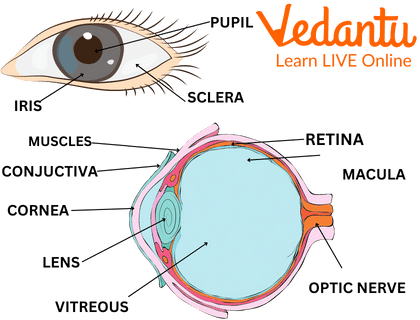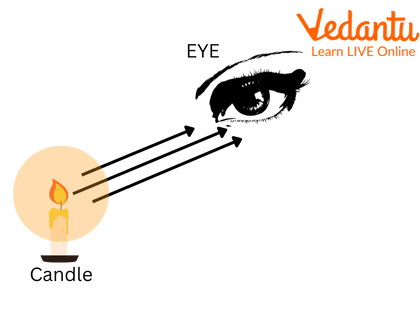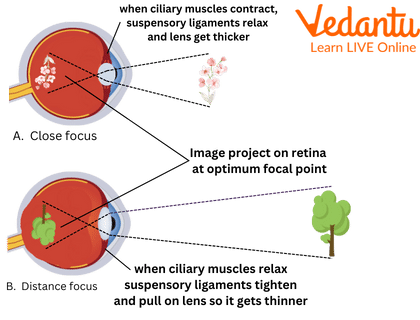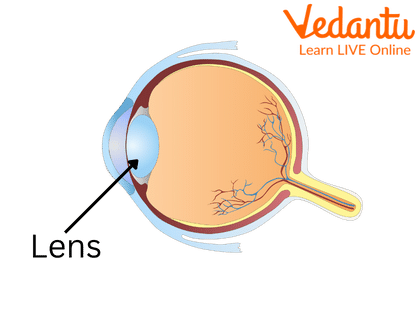




Human Eye: Focus
The human eye is one of the five sense organs that we have, and it is responsible for our vision. It helps us see the beautiful world around us. Our eyes first detect the object, and then the image of the object is formed on the retina (a part of the eye) of our eye then a signal related to the image is sent to the brain, where our brain finally analyses and comprehends the image. This is how we see the world around us.

The Human Eye
Since the world around us is vast and there are millions of objects at different places and distances, our eyes can adjust accordingly; our eye lens can focus on objects at different lengths and distances from us. In this article, we will read about how phenomenal our eyes are and how they focus.
Eye Focus
The human eye has three layers of cells: the outermost, cornea, the middle: choroid and the innermost: retina.

The Three Layers in the Eye
The cornea is the outermost layer and mainly acts as a protective layer, behind this we have an eye lens which is held in place with the help of the eye ligaments. The lens and the cornea are collectively responsible for focusing the light rays coming from the object on the correct position on the retina.
The retina is the layer of the eye where the images are formed since it has special types of light-sensitive cells, which help in image formation and detection. The retina is also connected to the visual centre of the brain where the images are analysed through the optic nerve which carries the signal from the eye to the brain.
What is Focus in Light?
To form a sharp and clear it is important that the light rays coming from the object are focused correctly on the retina.

An Object Emitting Light Rays which are Detected by Our Eyes.
How Does the Eye Focus?
The light rays emitted by the object are mainly focused on 5the retina with the help of the cornea and the lens. The lens is capable of changing its shape and size to adjust accordingly to the incoming light rays, for example: if the object is nearby, the light rays spread out more than in case of when the object is far away from the eyes.
The eye muscles around the lens are responsible for changing the shape and size of the lens for better focusing. When the object is nearby, the muscles contract and the lens is made thinner. When the object is far, the muscles of the ligament relax and the lens is made thicker.

The Eye Focusing.
What is Eye Lens?
The eye has a lens whose main focus is to help focus the light rays coming from the object on the correct spot on the retina. It is placed behind the cornea and is held in place by the eye ligaments.

The Eye Lens
How to Make Eyes Sharp?
Some ways we can strengthen our eyes are:
Eating green leafy vegetables.
Eating healthy fruits and vegetables like carrots, which are rich in vitamin A helps our eyes by helping in the formation of more light-sensitive cells in the retina.
Exercising for better focus and movement of the eyes.
Getting enough sleep to let our eyes rest.
Using eye protection glasses while working long hours on the screen or while reading continuously.
Going for regular eye checkups.
Visiting an eye specialist if facing any issue with the eyes.
Sample Questions
State whether the following statements are correctly stated or not:
The cornea is only responsible for the protection of the eye.
Ans: False, it also helps in focusing along with the lens
The choroid is the innermost layer of the eye.
Ans: False, the retina is the innermost layer of the eye
The retina is the place in the eye where the image is supposed to form.
Ans: True, the image is formed on the retina.
The eye lens is capable of adjusting its shape and size to focus better.
Ans: True, the eye lens can adjust its shape and size for better focus.
The distance of the object does not matter, the eye lens works similarly in all cases.
Ans: False, the lens change shapes and size depending on the distance of the object to focus better
Learn by Doing
Match the part of the eye given in column one with its correct functioning given in the second column:
The eye lens a. Holding the eye lens in place
The cornea b. Focusing the light rays
The retina c. where the image is formed
The eye ligaments d. Contracting for adjusting
Muscles around the eye lens e. Protection of the eye.
Answers:
B
E
C
A
D
Summary
The human eye is one of the five sense organs responsible for our vision. It comprises three layers of cells: the outermost cornea, the middle layer choroid and the innermost retina. The retina is the place in our eyes where the image is formed. The cornea and the eye lens behind are mainly responsible for focusing the light rays coming from the object at the correct spot on the retina.
The eye lens is held in place by the ligaments and can change its shape and size to help us better depending on the distance between the eye and the object.
FAQs on How Do the Eyes Focus?
1. What is the basic mechanism of how the human eye focuses on objects?
The human eye focuses on objects by using its cornea and lens to bend, or refract, incoming light rays. This process converges the light to form a sharp, inverted image on the retina, a light-sensitive layer at the back of the eye. The retina then converts this light into electrical signals that are sent to the brain via the optic nerve, allowing us to perceive the image.
2. What specific roles do the cornea and the eye lens play in focusing light?
Both the cornea and the eye lens are essential for focusing, but they have different functions. The cornea, the transparent outer layer, performs the initial and most significant part of the light refraction. The eye lens, located behind the cornea, provides adjustable, fine-tuned focusing. It can change its shape to precisely focus light from objects at various distances onto the retina.
3. How does the eye adjust its focus for near and distant objects?
The eye's ability to adjust its focus is called accommodation. This is controlled by the ciliary muscles changing the shape of the lens:
- For distant objects: The ciliary muscles are relaxed. This makes the eye lens thinner and less convex, increasing its focal length to focus the parallel light rays onto the retina.
- For near objects: The ciliary muscles contract. This action makes the eye lens thicker and more convex, decreasing its focal length to bend the divergent light rays more sharply and focus them on the retina.
4. What is the importance of the ciliary muscles in the process of eye focusing?
The ciliary muscles are critically important because they are responsible for the eye's ability to accommodate. By contracting and relaxing, they control the tension on the eye lens, thereby changing its curvature and focal length. Without the action of these muscles, we would not be able to shift our focus between objects at different distances, and our vision would be blurry for either near or far objects.
5. Explain the complete pathway of light from an object to the brain for us to see an image.
The process of seeing involves several sequential steps. The pathway of light is as follows:
- Light rays from an object first pass through the transparent cornea.
- The light then travels through the pupil, whose size is controlled by the iris.
- Next, the light is focused by the eye lens.
- The focused light passes through the vitreous humour and forms a real, inverted image on the retina.
- Light-sensitive cells (rods and cones) in the retina convert the light energy into electrical signals.
- These signals are transmitted to the brain via the optic nerve, where the brain interprets the signals and perceives the object upright and in its correct form.
6. What is the power of accommodation of the eye, and what happens if it weakens?
The power of accommodation is the maximum ability of the eye lens to adjust its focal length to see both near and distant objects clearly. If this ability weakens, which often happens with age (a condition called presbyopia), the eye cannot focus properly on nearby objects, making tasks like reading difficult. A weakening of accommodation can also be related to common refractive errors like myopia (nearsightedness) and hypermetropia (farsightedness).
7. What are some real-world examples that demonstrate the eye's ability to focus?
The eye's focusing ability is evident in many daily activities. For example:
- A student in a classroom quickly shifting focus from the distant whiteboard to their nearby notebook.
- A driver focusing on the road ahead and then glancing at the car's dashboard or speedometer.
- Someone reading a book who looks up to see a person walking into the room.
- A birdwatcher focusing on a bird high up in a tree and then looking at their field guide.
In each case, the eye's lens rapidly changes shape to ensure a clear image is formed on the retina.









